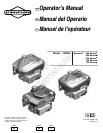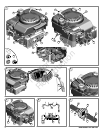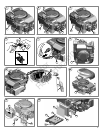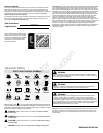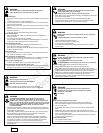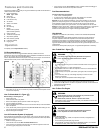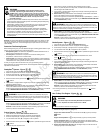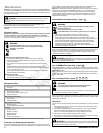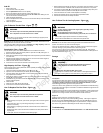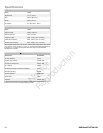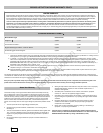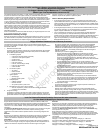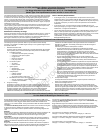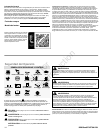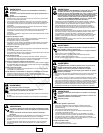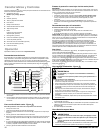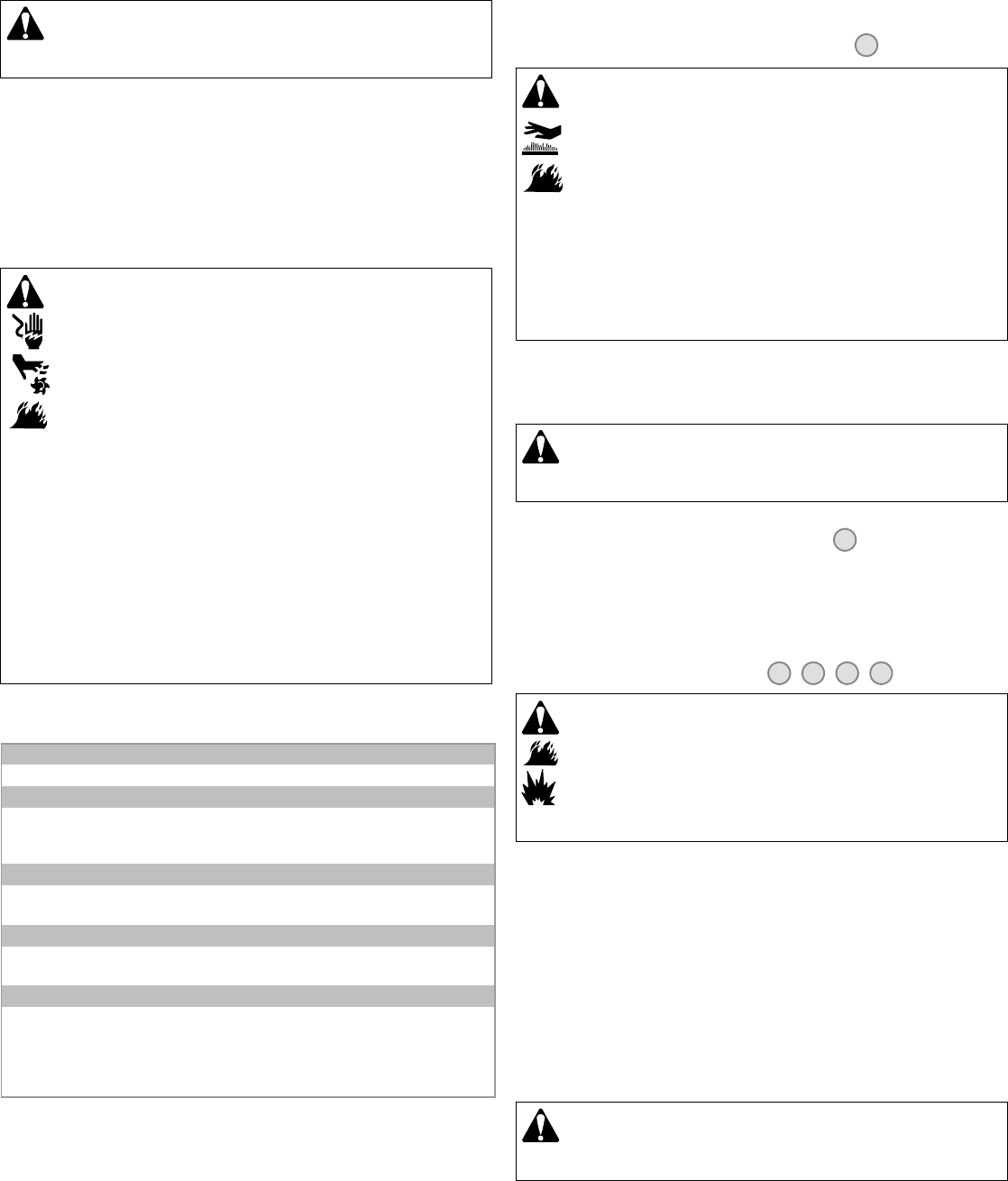
8
BRIGGSandSTRATTON.COM
Maintenance
NOTICE: If the engine is tipped during maintenance, the fuel tank must be empty and
thesparkplugsidemust be up. Ifthe fuel tank is notempty and ifthe engine is tippedin
any other direction, it may be difficult to start due to oil or gasoline contaminating the air
filter and/or the spark plug.
WARNING: When performing maintenance that requires the unit to be
tipped, the fuel tank must be empty or fuel can leak out and result in afire or
explosion.
We recommend that you see any Briggs & Stratton Authorized Dealer for all
maintenance and service of the engine and engine parts.
NOTICE: All the components used to build this engine must remain in place for proper
operation.
Emissions Control
Maintenance, replacement, orrepair of theemissions control devices and systems
may be performed by any off-road engine repair establishment or individual.
However, to obtain “no charge” emissions control service, the work must be performed
by a factory authorized dealer. See the Emissions Warranty.
Unintentional sparking can result in fire or electric shock.
Unintentional start-up can result in entanglement, traumatic
amputation, or laceration.
Fire hazard
WARNING
Before performing adjustments or repairs:
Disconnect the spark plug wire and keep it away from thespark plug.
Disconnect battery at negative terminal (only engines with electric start.)
Use only correct tools.
Do not tamper with governor spring, links or other parts to increaseengine
speed.
Replacement parts must be of the same design and installed in the same
position as the original parts. Other parts may notperform as well, may damage
the unit, and may result in injury.
Do not strike the flywheel with a hammer or hard object becauset he flywheel
may later shatter during operation.
When testing for spark:
Use approved spark plug tester.
Do not check for spark with spark plug removed.
Maintenance Chart
First 5 Hours
Change oil
Every8HoursorDaily
Check engine oil level
Clean area around muffler and controls
Clean finger guard
Every 25 Hours or Annually
Clean air filter *
Clean pre-cleaner *
Every 50 Hours or Annually
Change engine oil
Check muffler and spark arrester
Annually
Replace air filter
Replace pre-cleaner
Replace spark plug
Replace fuel filter
Clean air cooling system *
* In dusty conditions or when airborne debris is present, clean more often.
Carburetor And Engine Speed Adjustment
Never make adjustments to the carburetor or engine speed. The carburetor was set at
the factory to operate efficiently under most conditions. Do not tamper with the governor
spring, linkages, or other parts to change the engine speed. Ifany adjustments are
required contact a Briggs & Stratton Authorized Service Center for service.
NOTICE: The equipment manufacturer specifies the maximum speed for the engine as
installed on the equipment. Do not exceed this speed. If you are unsure what the
equipment maximum speed is, or what the engine speed is set to from the factory,
contact a Briggs & Stratton Authorized Service Center for assistance. For safe and
proper operation of the equipment, the engine speed should be adjusted only by a
qualified service technician.
Inspect Muffler And Spark Arrester - Figure
1
Running engines produce heat. Engine parts, especially muffler,
become extremely hot.
Severe thermal burns can occur on contact.
Combustible debris, such as leaves, grass, brush, etc. can catch fire.
WARNING
Allow muffler, engine cylinder and fins to cool before touching.
Remove accumulated debris from muff ler area and cylinder area.
It is a violation of California Public Resource Code, Section 4442, to useor
operate the engine onany forest-covered, brush-covered, or grass-covered land
unless the exhaust system is equipped with a spark arrester, as defined in
Section 4442, maintained in effective working order. Other states or federal
jurisdictions may have similar laws. Contact the original equipment
manufacturer, retailer, or dealer to obtain a spark arrester designed for the
exhaust system installed on this engine.
Remove accumulated debris from muffler area and cylinder area. Inspect the muffler (I,
Figure 1) for cracks, corrosion, or other damage. Remove the spark arrester (P), if
equipped, and inspect for damage or carbon blockage. If damage is found, install
replacement parts before operating.
WARNING: Replacement parts must be of the same design and installed
in the same position as the original parts. Other parts may not performas well, may
damage the unit, and may result in injury.
How To Replace The Spark Plug - Figure
10
Check the gap (A, Figure 10) with a wire gauge (B). If necessary, reset the gap. Install
and tightenthe sparkplug to the recommendedtorque. For gapsetting ortorque, seethe
Specifications section.
Note: In some areas, local law requires using a resistor spark plug to suppress ignition
signals. If this engine was originally equipped with a resistor spark plug, use the same
type for replacement.
How To Change The Oil - Figure
1 11 12 13
WARNING
Fuel and its vapors are extremely flammable and explosive.
Fire or explosion can cause severe burns or death.
If you drain the oil from the top oil fill tube, the fuel tank must be empty or fuel
can leak out and result in a fire or explosion.
Used oil is a hazardous waste product and must be disposed of properly. Do not discard
with householdwaste. Check with your localauthorities, service center,or dealer forsafe
disposal/ recycling facilities.
Remove Oil
You can drain the oilfrom the bottom drain hole, theside drain hole, orfrom the top oil fill
tube.
1. With engine off but still warm, disconnect the spark plug wire (A) and keep it away
from the spark plug (Figure 11).
2. The engine is equipped with a bottom drain (Q, Figure 1) and/or a side drain (R).
Removetheoildrainplug(H). Drain the oil into an approved container.
Note: Any of the oil drain plugs (H) shown may be installed in the engine.
3. After the oil has drained, install and tighten the oil drain plug.
4. If you drain the oil from the top oil fill tube (E), keep the spark plug end of the engine
(F) up (Figure 12). Drain the oil into an approved container.
WARNING: If you drain the oil from the top oil fill tube, the fuel tank must
be empty or fuel can leakout and result in a fire or explosion. To empty the fuel tank,
run the engine until it stops from lack of fuel.
Not for
Reproduction



